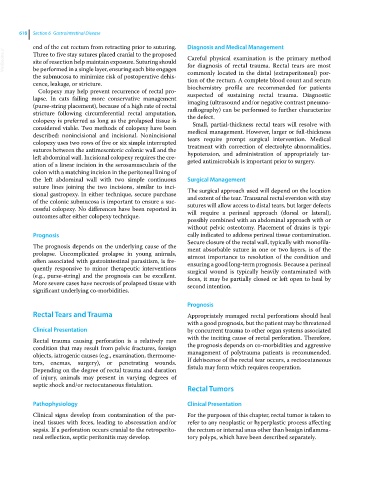Page 650 - Clinical Small Animal Internal Medicine
P. 650
618 Section 6 Gastrointestinal Disease
end of the cut rectum from retracting prior to suturing. Diagnosis and Medical Management
VetBooks.ir Three to five stay sutures placed cranial to the proposed Careful physical examination is the primary method
site of resection help maintain exposure. Suturing should
for diagnosis of rectal trauma. Rectal tears are most
be performed in a single layer, ensuring each bite engages
the submucosa to minimize risk of postoperative dehis- commonly located in the distal (extraperitoneal) por-
tion of the rectum. A complete blood count and serum
cence, leakage, or stricture. biochemistry profile are recommended for patients
Colopexy may help prevent recurrence of rectal pro-
lapse. In cats failing more conservative management suspected of sustaining rectal trauma. Diagnostic
imaging (ultrasound and/or negative contrast pneumo-
(purse‐string placement), because of a high rate of rectal radiography) can be performed to further characterize
stricture following circumferential rectal amputation, the defect.
colopexy is preferred as long as the prolapsed tissue is Small, partial‐thickness rectal tears will resolve with
considered viable. Two methods of colopexy have been medical management. However, larger or full‐thickness
described: nonincisional and incisional. Nonincisional tears require prompt surgical intervention. Medical
colopexy uses two rows of five or six simple interrupted treatment with correction of electrolyte abnormalities,
sutures between the antimesenteric colonic wall and the hypotension, and administration of appropriately tar-
left abdominal wall. Incisional colopexy requires the cre- geted antimicrobials is important prior to surgery.
ation of a linear incision in the serosamuscularis of the
colon with a matching incision in the peritoneal lining of
the left abdominal wall with two simple continuous Surgical Management
suture lines joining the two incisions, similar to inci- The surgical approach used will depend on the location
sional gastropexy. In either technique, secure purchase and extent of the tear. Transanal rectal eversion with stay
of the colonic submucosa is important to ensure a suc- sutures will allow access to distal tears, but larger defects
cessful colopexy. No differences have been reported in will require a perineal approach (dorsal or lateral),
outcomes after either colopexy technique.
possibly combined with an abdominal approach with or
without pelvic osteotomy. Placement of drains is typi-
Prognosis cally indicated to address perineal tissue contamination.
Secure closure of the rectal wall, typically with monofila-
The prognosis depends on the underlying cause of the ment absorbable suture in one or two layers, is of the
prolapse. Uncomplicated prolapse in young animals, utmost importance to resolution of the condition and
often associated with gastrointestinal parasitism, is fre- ensuring a good long‐term prognosis. Because a perineal
quently responsive to minor therapeutic interventions surgical wound is typically heavily contaminated with
(e.g., purse‐string) and the prognosis can be excellent. feces, it may be partially closed or left open to heal by
More severe cases have necrosis of prolapsed tissue with second intention.
significant underlying co‐morbidities.
Prognosis
Rectal Tears and Trauma Appropriately managed rectal perforations should heal
with a good prognosis, but the patient may be threatened
Clinical Presentation by concurrent trauma to other organ systems associated
Rectal trauma causing perforation is a relatively rare with the inciting cause of rectal perforation. Therefore,
condition that may result from pelvic fractures, foreign the prognosis depends on co‐morbidities and aggressive
objects, iatrogenic causes (e.g., examination, thermome- management of polytrauma patients is recommended.
ters, enemas, surgery), or penetrating wounds. If dehiscence of the rectal tear occurs, a rectocutaneous
Depending on the degree of rectal trauma and duration fistula may form which requires reoperation.
of injury, animals may present in varying degrees of
septic shock and/or rectocutaneous fistulation.
Rectal Tumors
Pathophysiology Clinical Presentation
Clinical signs develop from contamination of the per- For the purposes of this chapter, rectal tumor is taken to
ineal tissues with feces, leading to abscessation and/or refer to any neoplastic or hyperplastic process affecting
sepsis. If a perforation occurs cranial to the retroperito- the rectum or internal anus other than benign inflamma-
neal reflection, septic peritonitis may develop. tory polyps, which have been described separately.

